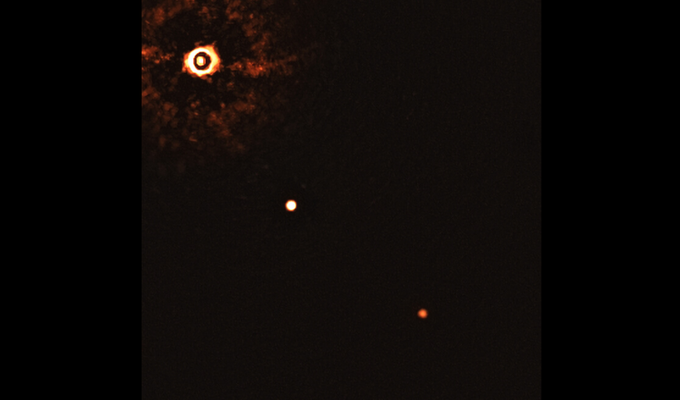The star in this image is “just” 17 million years old - this is young for a star! It’s like seeing a very young version of our own Sun, which is 4.6 billion years old.

While all images of the cosmos are beautiful and exciting, some are particularly special because they capture something rare or for the very first time.
This is the case for a team of astronomers who have revealed this new image of a rare family portrait taken by the European Southern Observatory’s Very Large Telescope.
A Rare Shot
This family portrait of a star and two exoplanets is a first! This is the first time astronomers have taken an image of a young, Sun-like star (the bright circle in the upper left corner) with two giant exoplanets (the two smaller dots in the image).
Today, we know of over 4000 exoplanets that exist in the Universe (and we expect there are many, many more!). However, nearly all of these exoplanets were found without seeing them directly. For example, astronomers look for dips in sunlight from other stars, which indicates a planet has passed in front of it!
This means that images of exoplanets are quite special. In particular, images of other systems with more than one exoplanet are extremely rare. Planets are usually hidden in the bright glare of their star and therefore hard to detect or snap an image of. Until now, astronomers had never directly observed more than one planet orbiting a star similar to our Sun.
This system is located roughly 300 light years away.
Understanding our Own Solar System
These observations can help astronomers understand how planets formed and evolved around our own Sun. This is because this system is very similar to our own solar system, but at a much earlier age.
The two exoplanets in this image are gas giants. A gas giant is a type of planet that mainly consists of gas and is much larger and heavier than rocky planets like our Earth or Mars. These new observations can help us understand our own two gas giants, Jupiter and Saturn. Still, the two imaged exoplanets do not completely resemble them: they are both further away from their star and heavier than Jupiter and Saturn. In fact, the largest of the two exoplanets is 14 times more massive than Jupiter (which is the largest planet in our solar system)!
The Very Large Telescope
This special family portrait was taken with the European Southern Observatory’s (ESO) Very Large Telescope (VLT). This telescope sits atop the Cerro Paranal mountain in the Atacama Desert of northern Chile. Because of the clear and dark skies in this environment, it can achieve sharp observations of the cosmos. The VLT is actually made up of four large individual telescopes that can operate separately or together as a team. Each of these telescopes hosts a large mirror that concentrates the light that is captured by the telescope.
Image credit: ESO/Bohn et al.
The star in this image is “just” 17 million years old - this is young for a star! It’s like seeing a very young version of our own Sun, which is 4.6 billion years old.